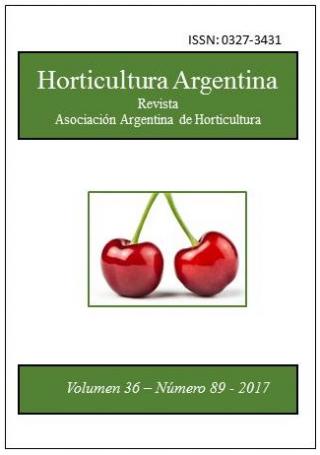Ver ítem
- xmlui.general.dspace_homeCentros Regionales y EEAsCentro Regional Mendoza - San JuanEEA La ConsultaArtículos científicosxmlui.ArtifactBrowser.ItemViewer.trail
- Inicio
- Centros Regionales y EEAs
- Centro Regional Mendoza - San Juan
- EEA La Consulta
- Artículos científicos
- Ver ítem
Rendimiento y calidad de semillas en cultivo de zanahoria implantado con mini raíces o cepellón = Yield and quality of seeds in carrot crop implanted with miniroots or speedling
Resumen
En la producción de semilla de zanahoria con el método semilla – semilla, la implantación del cultivo por trasplante se puede hacer con miniraíces o cepellones. El objetivo del ensayo fue comparar la implantación del cultivo empleando miniraíces o cepellones y determinar los efectos sobre el rendimiento y la calidad de semillas. Los ensayos se realizaron en San Carlos, Mendoza,Argentina, durante dos temporadas, con la cultivar Beatriz INTA. La plantación
[ver mas...]
En la producción de semilla de zanahoria con el método semilla – semilla, la implantación del cultivo por trasplante se puede hacer con miniraíces o cepellones. El objetivo del ensayo fue comparar la implantación del cultivo empleando miniraíces o cepellones y determinar los efectos sobre el rendimiento y la calidad de semillas. Los ensayos se realizaron en San Carlos, Mendoza,Argentina, durante dos temporadas, con la cultivar Beatriz INTA. La plantación fue en líneas a 0,80 m con igual densidad en todos los tratamientos (166.667 plantas.ha-1). Con las miniraíces se probaron dos tratamientos, trasplante de abril o agosto. Los cepellones se trasplantaron a fines de febrero y se probaron cuatro tratamientos variando las plantas por celda (1-2-3), el tamaño de bandeja (228 o 425 celdas) y la distancia de plantación a campo (7,5–15,0–22,5 cm). Se determinaron el número de plantas a cosecha y el rendimiento y la calidad de semillas. El análisis de la varianza fue conjunto para las dos temporadas, determinándose la interacción tratamiento*temporada. El rendimiento de semillas fue superior con los cepellones, sin diferenciarse entre sus variantes. El porcentaje de germinación no se modificó entre los tratamientos (media=96.9 %). Se aconseja el uso de cepellones obtenidos en bandejas de 425 celdas con dos plantas por celda, distanciados 15 cm en la línea de trasplante.
[Cerrar]
In carrot seed production with the method of seed – to –seed with transplant crop implantation, cultivation can be with miniroots or speedling. The aim of the test was to compare the implantation of the crop with miniroots or speedling and determine the effects on the yield and quality of seeds. Trials were conducted in San Carlos, Mendoza, Argentina, during the two seasons with the cultivar Beatriz INTA. The plantation was in lines to 0.80 m with equal
[ver mas...]
In carrot seed production with the method of seed – to –seed with transplant crop implantation, cultivation can be with miniroots or speedling. The aim of the test was to compare the implantation of the crop with miniroots or speedling and determine the effects on the yield and quality of seeds. Trials were conducted in San Carlos, Mendoza, Argentina, during the two seasons with the cultivar Beatriz INTA. The plantation was in lines to 0.80 m with equal density in all treatments (166,667 plants.ha-1). The miniroots were two treatments, transplant at the beginning of April or August. The speedlings were transplanted in late February. Four treatments were tested varying plants by cell (1-2-3), the sizes of tray (228 or 425-cell) and the distance of field plantation (7.5-15.0-22.5 cm). The number of plants at harvest and the yield and quality of seeds were determined. The analysis of variance was set for the two seasons determining the interaction treatment*season. Seed yield was higher with the use of speedlings, without differentiation between their variants. Germination percentage was not modified between treatments (mean = 96.9 %). The use of speedlings obtained in 425 cells with two plants per cell, distance 15 cm on the transplant line is recommended.
[Cerrar]

Autor
Fuente
Horticultura Argentina 36 (89) : 62-69. (Ene.-Abr. 2017)
Fecha
2017
Editorial
Asociación Argentina de Horticultura
ISSN
1851-9342 (Online)
0327-3431
0327-3431
Formato
pdf
Tipo de documento
artículo
Palabras Claves
Derechos de acceso
Abierto
 Excepto donde se diga explicitamente, este item se publica bajo la siguiente descripción: Creative Commons Attribution-NonCommercial-ShareAlike 2.5 Unported (CC BY-NC-SA 2.5)
Excepto donde se diga explicitamente, este item se publica bajo la siguiente descripción: Creative Commons Attribution-NonCommercial-ShareAlike 2.5 Unported (CC BY-NC-SA 2.5)


